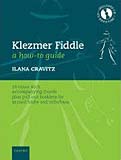Ilana Cravitz / Klezmer Fiddle: a how-to guide
Review by Eric Zaidins
 Ilana Cravitz
Ilana Cravitz
Klezmer Fiddle: a how-to guide
Format: Paperback, 96pp.
ISBN: 978-0193355842
Pub. Date: August 7, 2008
Publisher: Oxford University Press
$19.95 from Oxford University Press (www.oup.co.uk).
Also available through Amazon.com and fine vendors everywhere
For generations klezmer has been taught by passing down the music from one klezmer to the next by example. It’s only been in the last two or three generations that sheet music has become an additional means of sharing the musical tradition (for the purists, the "aural tradition" is still the only way!). Learning klezmer ain’t easy, especially if, like most of us, you haven’t grown up with it. Learning new modes (scales) and melodies are one reason. Compounding the problem is learning the ornamentation and improvisation techniques that give klezmer its uniquely Jewish soul. As with jazz, these elements derive from the personality of the player so they’re typically not found in off-the-shelf arrangements. Commercial sheet music is usually limited to simple melodies. Until now, you had two choices: teach yourself by listening to and imitating klezmer recordings, and/or studying with a master.
Klezmer Fiddle: a how-to guide, by Ilana Cravitz, is a hybrid, giving the violinist an alternative for mastering this genre. Cravitz, based in London, England, studied traditional klezmer fiddle technique with Deborah Strauss, Alicia Svigals and Michael Alpert, and has taught at workshops around Britain and in France, and at events like the Genius of the Violin Festival, KlezFest London, and Witney folk weekends.
The book begins with advice on how to use the guide. Then goes into an introductory discussion of the klezmer tradition that’s clear and concise— long enough to cover the subject but short enough to remain interesting. Next, a discussion of playing klezmer that includes an at-a-glance reference chart to klezmer’s style elements. Following that are 16 klezmer “Workshops and Tunes,” each broken down with a detailed description of the piece and an arrangement with instructions for playing it. It also comes with two other books: one for playing sekund accompaniment, and one for playing bass accompaniment (which was arranged by Stuart Brotman!).
The songs in the book, listed in order are:
- Freylekhs
- Nign
- Khosidl
- Freylekhs nokh der khupe
- Mekhutonim tsum tish
- Zhok
- Khosn kale mazeltov
- Zay gezunt
- Sirba
- Shver un shviger tants
- Sher
- Skotshne
- Terisher
- Bulgar
- Gas-nign
- Doyne
The guide closes with appendix charts of klezmer tune genres and associated dance styles, and a Yiddish glossary and pronunciation guide.
This is one of those concepts where you say to yourself, “Why didn’t I think of that!” Amazing that nobody has tried to tackle klezmer in such a way before. Cravitz has clearly done her homework, and the list of familiar and unfamiliar names in her acknowledgments and bibliography attest to that. She covers everything from bow technique to how to play the ornaments, including when and where they should be played. The different examples should help make it clear that they aren't set in stone and that they should be used in more of an improvisational and creative style. Although it's tough to say how well or how fast a violinist who has never heard klezmer will learn from this book, the included music CD demonstrates how each tune can be played. Cravitz chose her various selections well, and the simple recordings are easy to listen to and provide good models. The how-to element of this book is very effective, whether it's about reproducing some of the traditional ornaments or adding a sekund line. While giving lots of specific direction, Cravitz also provides alternate ways of playing a melody and leaves ample room for creativity and improvisation. It should be fairly easy to put together a very nice sounding ensemble in short order using the combination of her books.
Klezmer Fiddle: a how-to guide, a wonderful everything-you-always-wanted-to-know-about-klezmer-fiddle-but-were-afraid-to-ask book, is extremely comprehensive, and does a great job teaching a violinist how to play klezmer. It's a must for klezmorim who are seeking to master the art of the klezmer fiddle.
Many thanks to Jonathan Zaidins and Lori Horowitz who were asked to give a reviewer their thoughts on the technical aspects of the book. Jon, a founding member of the Westchester Klezmer Program, has been playing klezmer fiddle for nine years, and has studied with Lisa Meyer, Deborah Strauss, and Yaela Hertz. Lori, one of the Westchester Klezmer Program's teen/adult band members, is a semi-professional classical violinist, has been playing violin since she was seven, and stopped counting after 30 years. She's been playing klezmer since 2002, and has similarly studied with master klezmer fiddlers.
Reviewed by Eric Zaidins, October 17, 2008

